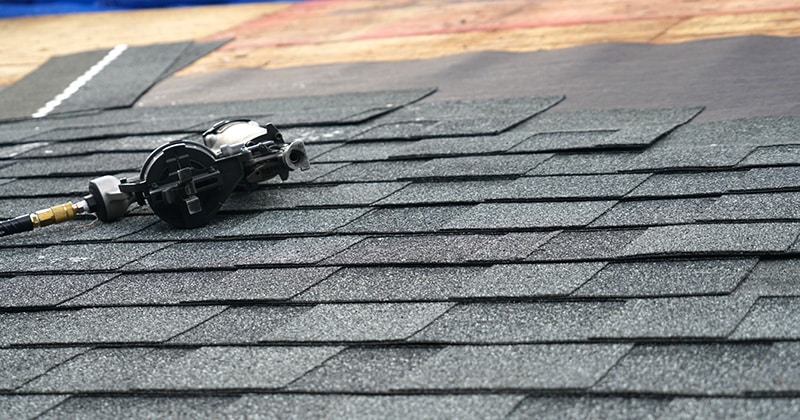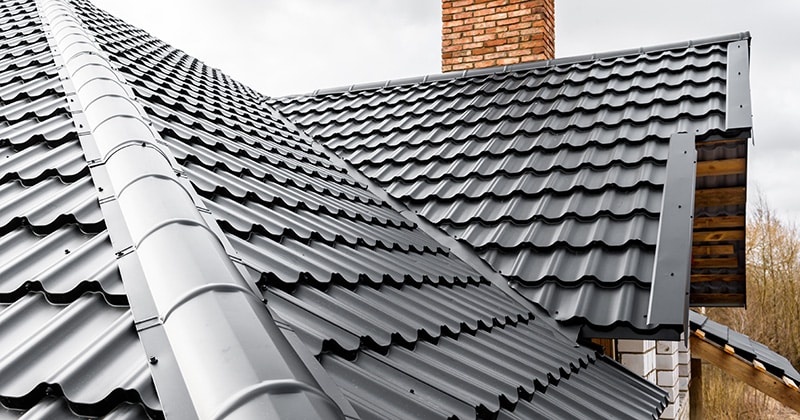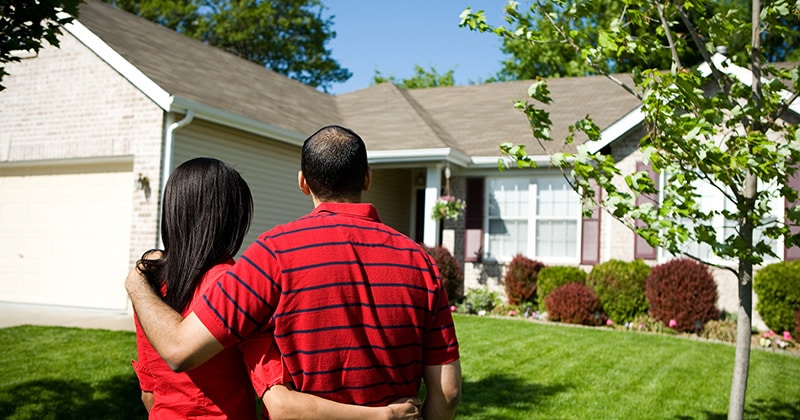Metal Roofs vs. Shingles: Which Should Roofers Recommend to Homeowners?
Helping your clients select the right materials for home improvement projects is vital. Here are some pros and cons for metal roofing vs. shingles, as well as how to help homeowners pick.

Staff Contributor
Helping your clients select the right materials for home improvement projects is vital. And when it comes to roofing, the proper materials can affect:
- The appearance of the property.
- How well the roof protects the home and conserves energy.
- The impact on the owner’s bank account.
For many roofing jobs, it boils down to a single decision. Should you recommend a metal roof or shingles.?
In this article, we’ll take a look at how these two options are different. We’ll consider the pros and cons of each material, including why homeowners might lean toward one or the other. And we’ll also share our tips for assisting homeowners in picking the kind of roof that will serve them best.
Let’s dive in.
The Difference Between Metal Roofing and Shingle Roofs
When you think of metal roofing, you may imagine the old noisy tin roofs of days past. However, today metal roofing is much improved. You’ll still find tin roofs, as well as metal roofing made of galvanized steel, aluminum, zinc, or copper.
Metal roofing comes in sheets that can be attached differently for a variety of looks. And metal roofing is gaining ground, though shingle roofs are still the go-to option.
Shingle roofing is available in several different materials, including wood, clay, and concrete. Generally speaking, asphalt is the most popular.
Asphalt shingles are now manufactured to mimic the appearance of other roofing choices but with less maintenance and at a lower cost.
Asphalt shingle roof material comes in rolls, stacks, or sheets. They’re nailed to a wooden surface on the roof. Shingles are made of a fiberglass base with smooth asphalt layered over it. The final layer is a granular finish that repels weather.
The Pros and Cons of Shingles

Asphalt shingles are easy to find at virtually any home supply or roofing supply store. Their popularity has endured for two main reasons.
- Asphalt shingles are less expensive than metal roofing.
- Asphalt shingles are easier to install than a metal roof.
The average national cost of asphalt roofing in 2021 was $22,636. Compare that to the average cost of metal roofing, which comes in at $38,600. The lower price point makes asphalt shingles an attractive option for homeowners on a budget.
Plus, because not every roofing company installs metal roofs, homeowners in some areas will have more options when picking a contractor.
In the event of roof damage or wear, it’s relatively easy to remove a section of asphalt shingles and make repairs. Metal roofing panels, on the other hand, may need to be replaced entirely. This requires more work and greater expense.
People can also walk on a shingle roof with little problem. This can be a bonus for homeowners who want easy roof access for chimney cleaning or holiday light displays.
The biggest issue with replacing asphalt shingles is that it can be difficult to match the exact color of the existing shingles. It’s smart to encourage the homeowner to buy extra shingle strips during roof installation. This helps with future repairs and offers the best match possible.
While there are plenty of advantages to asphalt shingles, the savings that come with asphalt shingles can be short-term. Sure, asphalt shingles are less expensive to install, repair, and replace. But they don’t last as long as a metal roof.
Homeowners can expect to replace shingle roofs more frequently. Asphalt shingles can be expected to last 15–30 years. Some metal roofs can last about twice as long.
Pros of Asphalt Shingles
- Considerably lower upfront cost compared to metal roofing
- Easier to finding qualified contractors to install asphalt shingles
- Relatively easy to repair
- Traditional, classic look
Cons of Asphalt Shingles
- Potential for damage to the roof due to the nature of the installation process
- Slightly lower fire resistance compared to metal roofing
- Easier to damage by hail, wind, or snow.
- Asphalt shingles, like pavement, hold heat in summer
- Subject to mold and mildew
- More challenging to recycle
The Pros and Cons of Metal Roofing

The greatest single advantage of a metal roof is its longevity.
A metal roof can last a lifetime when installed properly. This makes it a fantastic investment—one that increases property value, even though it costs more upfront.
The national average for the cost of a metal roof in 2021 was $38,600. However, over the course of 50 years, a homeowner will typically pay more in total for shingle roofing. A shingle roof will almost certainly have to be replaced at least once during that time.
In addition to the long-term savings, metal roofs are becoming more common aesthetically. A metal roof is striking and distinct. Not only that, but metal roofs come in a rainbow of color options.
For example, copper roofs will oxidize over time. This gives the roof a beautiful, green-tinted patina.The look is classic.
Homeowners can also opt for different patterns with metal roofing, further enhancing the architectural style of the property. Metal panels can be attached with flat or raised seams. This allows for a unique appearance.
Metal roofs are also an energy-efficient choice. They repel heat in summer and hold it inside in winter.
Plus, for property owners who crave a green lifestyle, it’s easier to attach solar panels to a metal roof for even greater energy savings.
Not only that, but metal roofs stand up better to most weather conditions than shingles. Metal is simple more resistant to hail and ice, rain, snow, wind, and temperature extremes.
But if you’re working on a home near the coast, take note. Saltwater can be corrosive to some kinds of metal. Care should be taken to select materials designed and treated for coastal regions.
Pros of Metal Roofing
- Metal roofing can increase a home’s value by up to 6%
- A metal roof can be fitted over an existing roof to eliminate tear-off costs and reduce waste
- Metal roofs can often bring insurance costs down due to their higher resistance to fire and durability
- Metal roofing is recyclable—provided it’s made of 100 percent polypropylene
Cons of Metal Roofing
- There are a limited number of roofing contractors who know how to install a metal roof properly
- Installation generally takes longer due to the skill and precision required
- Metal roofs can develop a wavy appearance known as “oil canning” on flat sections. This doesn’t affect their performance but may not be appealing to discerning homeowners.
- Some homeowners associations (HOAs) don’t allow metal roofing
- Insurance can be more complicated in areas at high risk for hail due to hail damage loss waivers
Reasons Why a Homeowner Might Want a Metal Roof
What are the reasons why a property owner may prefer a metal roof? Here are a few scenarios where you’d likely want to encourage a metal roof vs. shingles.
- The homeowner finds the prospect of more frequent roof replacement daunting. They want a “one and done” roof installation.
- The property owner intends to stay in the house for many years. They want the roof to appreciate during that time.
- The owner of the house can’t get the color or look they want with conventional shingles. This is often a concern for both historic and very contemporary homes.
- The owner wants to increase the value of the property to keep or sell.
- The homeowner is concerned with sustainability. They like the energy cost savings and recyclability.
- The property is in an area subject to weather extremes. A metal roof would likely experience less damage and fewer potential insurance claims.
Reasons Why a Homeowner Would Not Want a Metal Roof
There are some cases where a metal roof may not be the best choice. Here are several situations where asphalt shingles may be better.
- Budget is a concern. The homeowner doesn’t have the ability to pay for a metal roof.
- The property owner is flipping the home. They are more concerned about a fast and easy roof installation than about long-term property value.
- There are few or no qualified roofing contractors in the area who can install a metal roof.
- The property owner’s HOA forbids metal roofing.
- The homeowner prefers the appearance of traditional shingles over metal roofing.
- The owner is concerned about repairs and replacement in the future.
- The property owner does much of their own rooftop work and wants a safer surface to walk on.
- The home is in a coastal region. They have concerns about salt corrosion with the metal roof options available to them.
Pro Tips for Helping Homeowners Pick the Best Type of Roof for Their Home

Sometimes homeowners are on the fence about selecting a metal roof vs. shingles. How can you help them make the best choice for their individual needs?
Crunch the Numbers with Them
Help them understand the costs—long-term and short-term—for each material. Paying less upfront isn’t always a cost-saving.
If they intend to be in the house for a lifetime, a metal roof could be worth it. Or if they live in a high-end area where they can recoup the cost of a metal roof.
On the other hand, if they intend to sell in the near future, make sure any roof warranties can be transferred to a new owner. Also recommend the best roofing option for the greatest resale value.
Understand the Homeowner’s Needs Beyond the Budget
Are they worried about fires? What’s the weather like there throughout the year? Would they find multiple roof installations disruptive over time?
Talk through all the other things that come into play when selecting a roofing option.
Give Lots of Visuals
Find homes like theirs with different styles of roofing, both asphalt shingles and metal. This will help them visualize what they’re home will look like with each option.
Be Transparent About the Process
Don’t be overly optimistic about your ability to install a complicated metal roof. And don’t dismiss the extra time involved in tearing off old shingles. Be candid about your team’s experience.
Try to paint as clear a picture as possible. The better informed the homeowner is, the more likely they are to be satisfied when the job is done.
Take Your Time
Take an appropriate amount of time to guide homeowners through their roofing selection. Yes, it would be nice to close a new account quickly.
In the end, you benefit more from a smooth customer experience than a quick close.
How to Help Your Customer Decide: Metal or Shingle

Here are some quick questions you can use when visiting with a homeowner to help them determine the best type of roof for their home.
- Do you want to pay more now for longer results (metal) or pay less now knowing you could incur more overall costs in the long run (shingles)?
- Are you planning to stay in this home for years (metal) or are you getting ready to sell (shingles)?
- Do you ever go onto your roof for any reason (shingles) or is it extremely rare that you would have reason to go on your roof (metal)?
- Is the weather unpredictable and sometime extreme (metal) or fair and relatively consistent (shingles)?
- Are you worried about sustainability (metal) or more invested in low-cost convenience (shingles)?
- Does your HOA allow for metal roofs (metal) or are metal roofs not allowed in your neighborhood (shingles)?
A good roof is like a good haircut. When someone is well groomed, you may take a second look. Falling apart and unkempt could be a drive-by.
You want your customers’ neighbors to ask, “Who did your roof?” That’s how you further establish your roofing company as the go-to contractor in your area.


